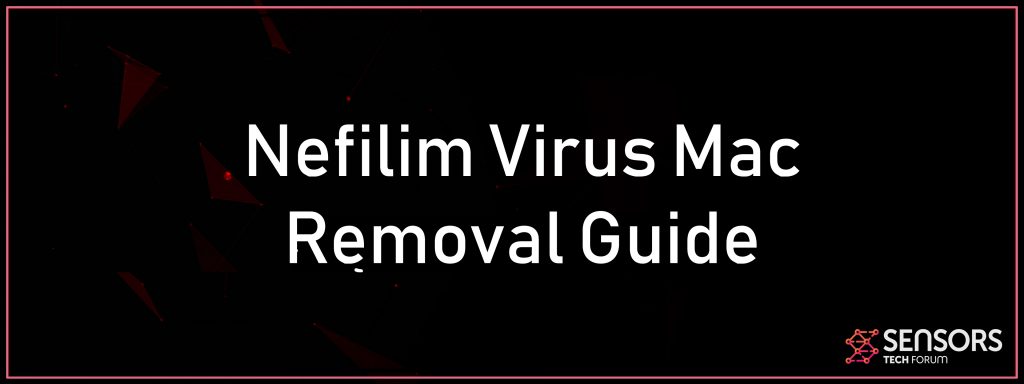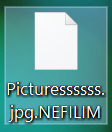The Nefilim infection is a ransomware that is presently set against target end users on an international range. There is no info offered concerning the hacking group behind it. It is believed to be a brand-new model of the well-known ransomware family. This is just one of the reasons that we believe that the cyberpunks are experienced.
Once the Nefilim virus has actually started it will certainly perform its built-in series of unsafe commands. Relying on regional conditions or the specific hacker directions numerous activities will certainly happen. The data encryption will begin after them– the encrypting part will scan for a list of target files by their extensions. In the long run the victim data will certainly be renamed with the .NEFILIM extesion.
The Nefilim virus which is additionally known as the Nefilim Ransomware is a new malware risk that is currently set against computer sufferers. There is no details concerning the hacking team readily available as well as this likewise implies that there is no information gathered concerning te recommended distribution method.

Threat Summary
| Name | Nefilim Virus |
| File Extension | .NEFILIM |
| Type | Ransomware, Cryptovirus |
| What Is It | The Nefilim ransomware virus aims to encrypt your computer and then extort your into paying ransom in BitCoin or other cryptocurrencies. |
| Symptoms | The Nefilim virus has various different types of symtoms – files become with the .NEFILIM extension and the virus may leave a ransom note. |
| Ransom Demanding Note | N/A |
| Distribution Method | Spam Emails, Email Attachments, Executable Files, Hacked Websites |
| Removal | To effectively remove active Nefilim Virus virus infections, we recommend that you use an advanced anti-malware tool. Download
Malware Removal Tool
|
User Experience | Join Our Forum to Discuss Nefilim Virus. |
| Data Recovery Tool | Windows Data Recovery by Stellar Phoenix Notice! This product scans your drive sectors to recover lost files and it may not recover 100% of the encrypted files, but only few of them, depending on the situation and whether or not you have reformatted your drive. |
Nefilim Virus May 2020 Update
In recent news the Nefilim virus was used in a dangerous attack campaign by an unknown hacking group. This month (May 2020) the criminals have breached the Toll Group leaking data that totals 200 GB. This company is a subsidiary of Japan Host Holdings and works in the logistics sector based in Australia.
Data about the incident reveals that this has been done in two parts. The first one appears to be old accounting data while the secone one includes personnel files.
This incident shows that the hackers are continuing with the virus attacks — given the fact that they have been able to intrude onto the servers of a company of such size shows that it is expected for more breaches to follow.
Nefilim Virus April 2020 Update
A dangerous new attack campaign carrying the Nefilim Virus has been reported to have hit two major companies: Cosan and MAS Holdings. Cosan is a very large Brazilian producer of sugar, energy and bio ethanol and operates across a large number of countries.
The other company which has been breached by the ransomware is MAS Holdings which is the largest manufacturer in South Asia of lingerie. It operates manufacturing plants across all continents and has hubs in all major cities. Customers of the holding include Victoria’s Secret, Nike and PVH.
In the case of Cosan the hackers have tried to negotiate with the company for a ransomware payment however ultimately failed. This has lead to the public release of sensitive company files.
Nefilim Virus March 2020 Update
Further information became available about the Nefilim virus which appears to include code taken from the NEMTY family of viruses. There are two hypotheses regarding the origins of the malware — the first one is that the same hackers behind the NEMTY may have created Nefilim. The other proposal is that the hackers that have created this threat by accessing NEMTY’s code and modifying it.
The new version of Nefilim removes the RaaS (Ransomware-as-a-service) model and now focuses on the sending via customized campaigns. The local client of the infected computers will start a TOR client which will redirect the victims to a ransom page which is hosted on the anonymous network.
Another addition in the new version is that the ransom note will blackmail the victims into believing that their data will be leaked to the public unless the sum is paid. The users are given seven days in order to pay the designated fee.
Nefilim Ransomware – Description
The files, encrypted by Nefilim virus look like the following:
It is extremely possible that one of the most prominent ways of infecting with Nefilim virus are going to be utilized. Several of them consist of the following:
Phishing Campaigns— The criminals can arrange massive phishing campaigns which are readied to manipulate the victims right into believing that they are connecting with a reputable notice or message. Both most usual kinds are email messages and also hacker-controlled sites. They can be held on domain names that sound very similar to the ones which are posed. Self-signed protection certifications can be posted.
Malware URLs— The infection code can be placed in macro-infected papers or setup bundles– they can be of prominent programs which are typically downloaded and install by end users.
File Infection— These documents can be spread over to file-sharing networks such as BitTorrent and also even numerous social networks, chat rooms, online forums and also etc.
As quickly as the Nefilim virus is mounted on an offered computer a considerable checklist of elements as well as components will be run. The security evaluation shows that one of the innovative functionality which is included in the virus code is the capability to begin, quit and also engage with system device drivers, consisting of the capability to mount the malware code via them– this will certainly bypass most of the safety and security systems and also applications which are mounted on the host computer.
The Nefilim virus running procedure will certainly be allocated to a scheduled memory space– this will make it a lot harder to stop the running procedures. This is likewise used to secure the ransomware from debug settings and also online mchine hosts execution.
The virus likewise consists of an innovative details celebration module which has actually been located to obtain information in two groups:
Equipment Information— This can create a complete report of the installed hardware parts and also particular system atmosphere values.
Personal Details— It is really feasible that this engine can be used to get details that can expose the identity of the individuals.
The Nefilim virus may also interact with the system using the os services– this will enable the primary engine to perform different changes including the capability to set itself as a relentless risk– it will certainly begin automatically when the computer is powered on.
The primary infection engine can likewise communicate with the system place manager– it can access readily available network shares and also detachable tools which will be infected by the Nefilim virus. Any kind of alterations to vital system setup files and the Windows registry might result in serious performance concerns, information loss and also unforeseen mistakes.
The Nefilim infection is a ransomware which will utilize the normal technique of using an integrated checklist of target data types– they will consist of often accessed information: archives, back-ups, databases, multimedia documents and etc. The processed files will certainly be relabelled with the appropriate .NEFILIM extension and a ransom money note will be created in a documents called README.html.

How to Remove Nefilim Virus
If your computer system got infected with the Nefilim Documents ransomware virus, you should have a little experience in eliminating malware. You should do away with this ransomware as quickly as feasible before it can have the opportunity to spread additionally and infect other computers. You ought to get rid of the ransomware and adhere to the step-by-step directions assist offered below.
- Step 1
- Step 2
- Step 3
- Step 4
- Step 5
Step 1: Scan for Nefilim Virus with SpyHunter Anti-Malware Tool



Ransomware Automatic Removal - Video Guide
Step 2: Uninstall Nefilim Virus and related malware from Windows
Here is a method in few easy steps that should be able to uninstall most programs. No matter if you are using Windows 10, 8, 7, Vista or XP, those steps will get the job done. Dragging the program or its folder to the recycle bin can be a very bad decision. If you do that, bits and pieces of the program are left behind, and that can lead to unstable work of your PC, errors with the file type associations and other unpleasant activities. The proper way to get a program off your computer is to Uninstall it. To do that:


 Follow the instructions above and you will successfully delete most unwanted and malicious programs.
Follow the instructions above and you will successfully delete most unwanted and malicious programs.
Step 3: Clean any registries, created by Nefilim Virus on your computer.
The usually targeted registries of Windows machines are the following:
- HKEY_LOCAL_MACHINE\Software\Microsoft\Windows\CurrentVersion\Run
- HKEY_CURRENT_USER\Software\Microsoft\Windows\CurrentVersion\Run
- HKEY_LOCAL_MACHINE\Software\Microsoft\Windows\CurrentVersion\RunOnce
- HKEY_CURRENT_USER\Software\Microsoft\Windows\CurrentVersion\RunOnce
You can access them by opening the Windows registry editor and deleting any values, created by Nefilim Virus there. This can happen by following the steps underneath:


 Tip: To find a virus-created value, you can right-click on it and click "Modify" to see which file it is set to run. If this is the virus file location, remove the value.
Tip: To find a virus-created value, you can right-click on it and click "Modify" to see which file it is set to run. If this is the virus file location, remove the value.
Before starting "Step 4", please boot back into Normal mode, in case you are currently in Safe Mode.
This will enable you to install and use SpyHunter 5 successfully.
Step 4: Boot Your PC In Safe Mode to isolate and remove Nefilim Virus





Step 5: Try to Restore Files Encrypted by Nefilim Virus.
Method 1: Use STOP Decrypter by Emsisoft.
Not all variants of this ransomware can be decrypted for free, but we have added the decryptor used by researchers that is often updated with the variants which become eventually decrypted. You can try and decrypt your files using the instructions below, but if they do not work, then unfortunately your variant of the ransomware virus is not decryptable.
Follow the instructions below to use the Emsisoft decrypter and decrypt your files for free. You can download the Emsisoft decryption tool linked here and then follow the steps provided below:
1 Right-click on the decrypter and click on Run as Administrator as shown below:

2. Agree with the license terms:
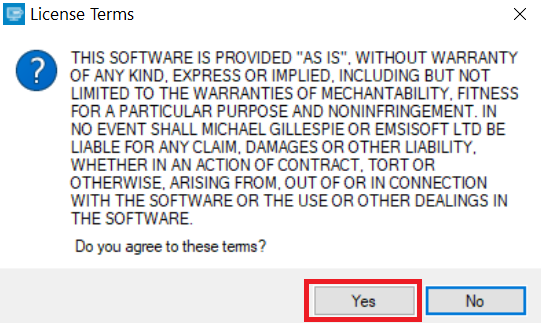
3. Click on "Add Folder" and then add the folders where you want files decrypted as shown underneath:
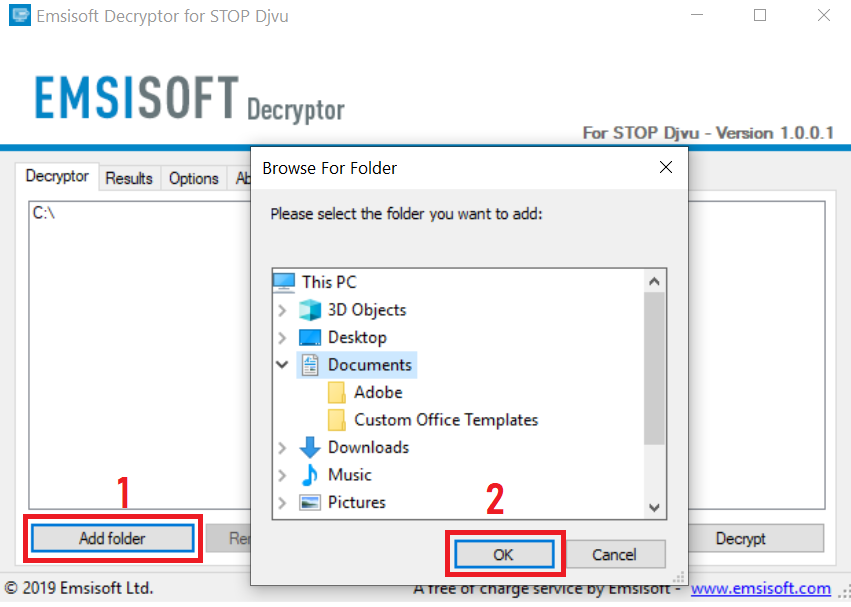
4. Click on "Decrypt" and wait for your files to be decoded.
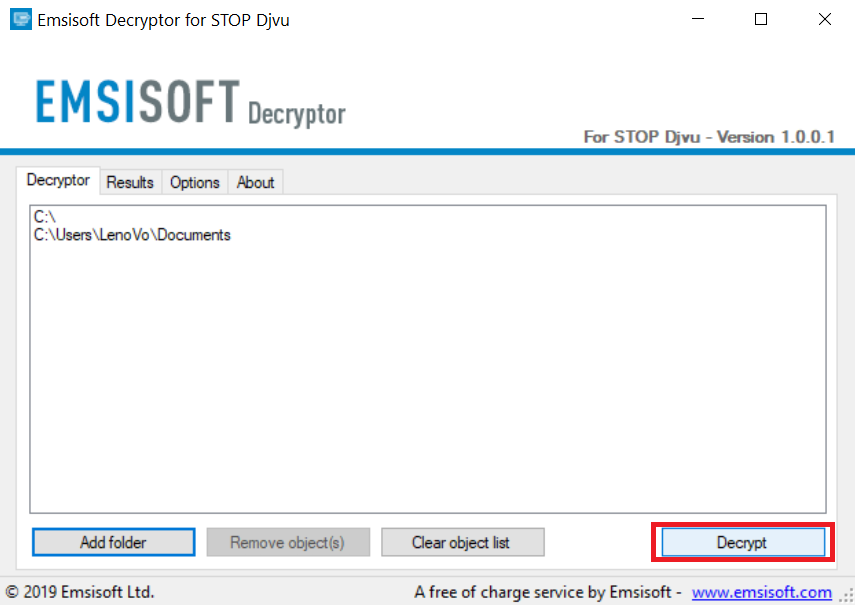
Note: Credit for the decryptor goes to Emsisoft researchers who have made the breakthrough with this virus.
Method 2: Use data recovery software
Ransomware infections and Nefilim Virus aim to encrypt your files using an encryption algorithm which may be very difficult to decrypt. This is why we have suggested a data recovery method that may help you go around direct decryption and try to restore your files. Bear in mind that this method may not be 100% effective but may also help you a little or a lot in different situations.
Simply click on the link and on the website menus on the top, choose Data Recovery - Data Recovery Wizard for Windows or Mac (depending on your OS), and then download and run the tool.
Nefilim Virus-FAQ
What is Nefilim Virus Ransomware?
Nefilim Virus is a ransomware infection - the malicious software that enters your computer silently and blocks either access to the computer itself or encrypt your files.
Many ransomware viruses use sophisticated encryption algorithms to make your files inaccessible. The goal of ransomware infections is to demand that you pay a ransom payment to get access to your files back.
What Does Nefilim Virus Ransomware Do?
Ransomware in general is a malicious software that is designed to block access to your computer or files until a ransom is paid.
Ransomware viruses can also damage your system, corrupt data and delete files, resulting in the permanent loss of important files.
How Does Nefilim Virus Infect?
Via several ways.Nefilim Virus Ransomware infects computers by being sent via phishing emails, containing virus attachment. This attachment is usually masked as an important document, like an invoice, bank document or even a plane ticket and it looks very convincing to users.
Another way you may become a victim of Nefilim Virus is if you download a fake installer, crack or patch from a low reputation website or if you click on a virus link. Many users report getting a ransomware infection by downloading torrents.
How to Open .Nefilim Virus files?
You can't without a decryptor. At this point, the .Nefilim Virus files are encrypted. You can only open them once they are decrypted using a specific decryption key for the particular algorithm.
What to Do If a Decryptor Does Not Work?
Do not panic, and backup the files. If a decryptor did not decrypt your .Nefilim Virus files successfully, then do not despair, because this virus is still new.
Can I Restore ".Nefilim Virus" Files?
Yes, sometimes files can be restored. We have suggested several file recovery methods that could work if you want to restore .Nefilim Virus files.
These methods are in no way 100% guaranteed that you will be able to get your files back. But if you have a backup, your chances of success are much greater.
How To Get Rid of Nefilim Virus Virus?
The safest way and the most efficient one for the removal of this ransomware infection is the use a professional anti-malware program.
It will scan for and locate Nefilim Virus ransomware and then remove it without causing any additional harm to your important .Nefilim Virus files.
Can I Report Ransomware to Authorities?
In case your computer got infected with a ransomware infection, you can report it to the local Police departments. It can help authorities worldwide track and determine the perpetrators behind the virus that has infected your computer.
Below, we have prepared a list with government websites, where you can file a report in case you are a victim of a cybercrime:
Cyber-security authorities, responsible for handling ransomware attack reports in different regions all over the world:
Germany - Offizielles Portal der deutschen Polizei
United States - IC3 Internet Crime Complaint Centre
United Kingdom - Action Fraud Police
France - Ministère de l'Intérieur
Italy - Polizia Di Stato
Spain - Policía Nacional
Netherlands - Politie
Poland - Policja
Portugal - Polícia Judiciária
Greece - Cyber Crime Unit (Hellenic Police)
India - Mumbai Police - CyberCrime Investigation Cell
Australia - Australian High Tech Crime Center
Reports may be responded to in different timeframes, depending on your local authorities.
Can You Stop Ransomware from Encrypting Your Files?
Yes, you can prevent ransomware. The best way to do this is to ensure your computer system is updated with the latest security patches, use a reputable anti-malware program and firewall, backup your important files frequently, and avoid clicking on malicious links or downloading unknown files.
Can Nefilim Virus Ransomware Steal Your Data?
Yes, in most cases ransomware will steal your information. It is a form of malware that steals data from a user's computer, encrypts it, and then demands a ransom in order to decrypt it.
In many cases, the malware authors or attackers will threaten to delete the data or publish it online unless the ransom is paid.
Can Ransomware Infect WiFi?
Yes, ransomware can infect WiFi networks, as malicious actors can use it to gain control of the network, steal confidential data, and lock out users. If a ransomware attack is successful, it could lead to a loss of service and/or data, and in some cases, financial losses.
Should I Pay Ransomware?
No, you should not pay ransomware extortionists. Paying them only encourages criminals and does not guarantee that the files or data will be restored. The better approach is to have a secure backup of important data and be vigilant about security in the first place.
What Happens If I Don't Pay Ransom?
If you don't pay the ransom, the hackers may still have access to your computer, data, or files and may continue to threaten to expose or delete them, or even use them to commit cybercrimes. In some cases, they may even continue to demand additional ransom payments.
Can a Ransomware Attack Be Detected?
Yes, ransomware can be detected. Anti-malware software and other advanced security tools can detect ransomware and alert the user when it is present on a machine.
It is important to stay up-to-date on the latest security measures and to keep security software updated to ensure ransomware can be detected and prevented.
Do Ransomware Criminals Get Caught?
Yes, ransomware criminals do get caught. Law enforcement agencies, such as the FBI, Interpol and others have been successful in tracking down and prosecuting ransomware criminals in the US and other countries. As ransomware threats continue to increase, so does the enforcement activity.
About the Nefilim Virus Research
The content we publish on SensorsTechForum.com, this Nefilim Virus how-to removal guide included, is the outcome of extensive research, hard work and our team’s devotion to help you remove the specific malware and restore your encrypted files.
How did we conduct the research on this ransomware?
Our research is based on an independent investigation. We are in contact with independent security researchers, and as such, we receive daily updates on the latest malware and ransomware definitions.
Furthermore, the research behind the Nefilim Virus ransomware threat is backed with VirusTotal and the NoMoreRansom project.
To better understand the ransomware threat, please refer to the following articles which provide knowledgeable details.
As a site that has been dedicated to providing free removal instructions for ransomware and malware since 2014, SensorsTechForum’s recommendation is to only pay attention to trustworthy sources.
How to recognize trustworthy sources:
- Always check "About Us" web page.
- Profile of the content creator.
- Make sure that real people are behind the site and not fake names and profiles.
- Verify Facebook, LinkedIn and Twitter personal profiles.













